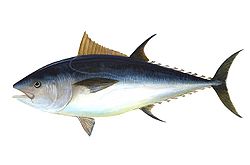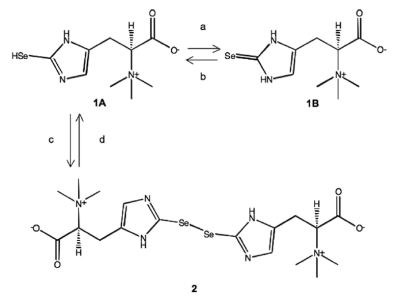A japanese research team now has identified the major organo-selenium compound in tuna blood as 2-selenyl-N,N,N-trimethyl-L-histidine, a selenium analog of ergothioneine.
Background:Selenium is an essential element both for humans and animals that functions as selenocysteine for the reduction of antioxidant enzymes such as gluthathione peroxodases, thioredoxin reductase, and thyroid hormone deiodinases. The entire selenoprotein gene population, designated the selenoproteome, has been identified in humans and rodents, and numerous selenoprotein genes have functions in development and health. The antioxidant activity of selenium plays a protective role in numerous diseases, including cancer, immunodeficiency and cardiovascular diseases. Selenium also protects against toxic metals such as mercury, cadmium and lead.

Fig. 1: Bluefin tuna
|
Fish consumption is a major source of Se in the human diet for fish
eating populations such as the Japanese. Red muscle and other tissues of
tuna contain organic selenium in excess of 1 ppm, making this the
highest selenium content in food. Both the structure of the
organoselenium compounds as well as their antioxidant activity are only
poorly characterized.
The new study:Researchers from the National Research Institute of Fisheries Science in Japan now have investigated the major organic selenium compound in the blood and tissues of the bluefin tuna. Using multistep chromatographic separation including reversed-phase HPLC and size exclusion chromatography the researchers could obtain a yelloy oily compound of 200 µg from 100 g of tuna blood. High resolution mass spectrometry using electrospray ionization revealed a molecular ion peak at m/z 553.0562 that indicated the molecular formula C
18H
29N
6O
4Se
2. Also the isotopic pattern of the compound matched the theoretical isotopic pattern of two selenium atoms. MS/MS fragmentation patterns indicated the presence of an selenium-containing imidazole ring, a carboxyl group, and a trimethylamine group.

Fig.2: The chemical structure of the selenium-containing compound selenoneine (1A, 1B) and its autoxidized dimer (2)
|
Using further analytical methods such as 13C-NMR the compound was identified as 2-selenyl-N,N,N-trimethyl-L-histidine, a selenium analog of ergothioneine that was called “selenoneine”. Using LC-ICP-MS for Se-speciation analysis, the researchers further analyzed the distribution of Se-species in various tuna tissues. Selenoneine was found to be the major Se-compound in many animal tissues such as blood, hepatopancreas, spleen, heart, and skeletal muscle of the tuna, mackerel and tilapia blood, porcine kidney, chicken gizzard, liver, heart, and squid hepatopancreas.
The authors conclude, that further study is needed to examine whether selenoneine might be a non-toxic organic selenium in animal tissues and cells, in comparison with the high toxicity of known selenium compounds such as selenocysteine (LD50 35.8 mg/kg), selenomethionine (LD50 4.3 mg/kg), and selenite (LD50 3.5 mg/kg).
 The original study
The original study
Yumiko Yamashita, Michiaki Yamashita,
Identification of a Novel Selenium-containing Compound, Selenoneine, as the Predominant Chemical Form of Organic Selenium in the Blood of Bluefin Tuna, J. Biol. Chem., 285/24 (2010) 18134-18138.
DOI: 10.1074/jbc.C110.106377 Related studies
Related studies
Oscar Palacios, Jorge Ruiz Encinar, Gérard Bertin,
Ryszard Lobinski,
Analysis of the selenium species distribution in cow blood by size exclusion liquid chromatography-inductively coupled plasma collision cell mass spectrometry (SEC-ICPccMS), Anal. Bioanal. Chem., 383/3 (2005) 516-522.
DOI: 10.1007/s00216-005-0015-8
Gregory V. Kryukov, Sergi Castellano, Sergey V. Novoselov, Alexey V. Lobanov, Omid Zehtab, Roderic Guigo´, Vadim N. Gladyshev,
Characterization of Mammalian Selenoproteomes, Science, 300 (2003) 1439-1443.
DOI: 10.1126/science.1083516
 Kazuo T. Suzuki
Kazuo T. Suzuki, Y. Ogra,
Metabolic pathway for selenium in the body: speciation by HPLC-ICP-MS with enriched Se, Food Addit. Contam., 19/10 (2002) 974-983.
DOI: 10.1080/02652030210153578
Karam El-Bayoumy,
The protective role of selenium on genetic damage and on cancer, Mutat. Res., 475/1-2 (2001) 123-139.
DOI: 10.1016/S0027-5107(01)00075-6

Yamato Shiobara, Yasumitsu Ogra,
Kazuo T. Suzuki,
Speciation of metabolites of selenate in rats by HPLC-ICP-MS, Analyst, 124/8 (1999) 1237-1241.
DOI: 10.1039/a902922b
Ma. Lourdes A. Cuvin-Aralar, Robert W. Furness,
Mercury and selenium interaction: A review, Ecotoxicol. Environ. Safety, 21/3 (1991) 348-364.
DOI: 10.1016/0147-6513(91)90074-Y  Related EVISA Resources
Related EVISA Resources Brief Summary: ESI-MS: The tool for the identification of chemical species
Brief Summary: ESI-MS: The tool for the identification of chemical species Brief Summary: LC-ICP-MS: The most often used hyphenated system for speciation
analysis
Brief Summary: LC-ICP-MS: The most often used hyphenated system for speciation
analysis Link Database: Toxicity of Organo-Selenium compounds
Link Database: Toxicity of Organo-Selenium compounds Link Database: Organo-Selenium compounds and human health
Link Database: Organo-Selenium compounds and human health Related EVISA News (newest first)
Related EVISA News (newest first)
 August 16, 2016: Toxicity and bioavailability of different selenium metabolites
August 16, 2016: Toxicity and bioavailability of different selenium metabolites
 July 21, 2015: Polish selenium supplements not always labeled accurately
July 21, 2015: Polish selenium supplements not always labeled accurately
 December 17, 2014: Decreased risk of colorectal cancer linked with higher selenium status
December 17, 2014: Decreased risk of colorectal cancer linked with higher selenium status
 August 9, 2011: New selenium metabolites found in human serum
August 9, 2011: New selenium metabolites found in human serum May 22, 2011: Does Selenium Prevent Cancer? It May Depend on Which Form People Take
May 22, 2011: Does Selenium Prevent Cancer? It May Depend on Which Form People Take
 May 12, 2011: Review: Selenium doesn't prevent cancer
May 12, 2011: Review: Selenium doesn't prevent cancer June 19, 2010: A
new Selenium-containing compound, Selenoneine, found as the predominant
Se-species in the blood of Bluefin Tuna
June 19, 2010: A
new Selenium-containing compound, Selenoneine, found as the predominant
Se-species in the blood of Bluefin Tuna  July 20, 2009: Researchers Reveal Selenium's Metabolism In Life-Giving Amino Acids
July 20, 2009: Researchers Reveal Selenium's Metabolism In Life-Giving Amino Acids October 28, 2008: National Cancer Institute ends Selenium and Vitamin E Cancer
Prevention Trial, or SELECT
October 28, 2008: National Cancer Institute ends Selenium and Vitamin E Cancer
Prevention Trial, or SELECT March 16, 2008: New selenium-containing proteins identified in selenium-rich yeast
March 16, 2008: New selenium-containing proteins identified in selenium-rich yeast October 16, 2005: New light on human selenium metabolism
October 16, 2005: New light on human selenium metabolism October 6, 2005: Selenomethionine shows promising results as a protective agent
against Esophageal Cancer
October 6, 2005: Selenomethionine shows promising results as a protective agent
against Esophageal Cancer March 8, 2005: Selenoprotein P is required for normal sperm development
March 8, 2005: Selenoprotein P is required for normal sperm development
last time modified: November 12, 2025